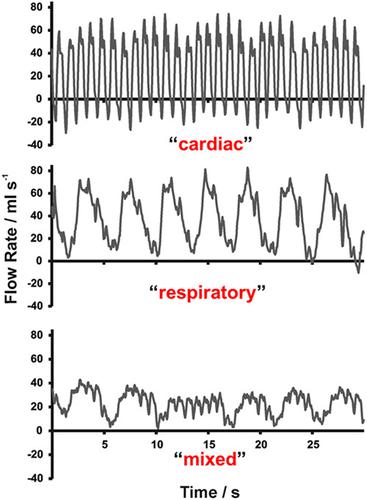当前位置:
X-MOL 学术
›
NMR Biomed.
›
论文详情
Our official English website, www.x-mol.net, welcomes your
feedback! (Note: you will need to create a separate account there.)
Inferior vena cava revisited - Real-time flow MRI of respiratory maneuvers.
NMR in Biomedicine ( IF 2.7 ) Pub Date : 2020-01-08 , DOI: 10.1002/nbm.4232 Arun A Joseph 1 , Dirk Voit 1 , Jens Frahm 1, 2
NMR in Biomedicine ( IF 2.7 ) Pub Date : 2020-01-08 , DOI: 10.1002/nbm.4232 Arun A Joseph 1 , Dirk Voit 1 , Jens Frahm 1, 2
Affiliation

|
Recent MRI studies of blood flow in the inferior vena cava (IVC) resulted in findings which are inconsistent with earlier observations by invasive procedures - most likely because ECG-gated MRI techniques are unable to resolve dynamic adjustments due to respiration. The purpose of this work was to apply real-time phase-contrast MRI at 50 ms resolution to re-evaluate IVC flow in response to normal and deep breathing as well as breath holding and Valsalva maneuver (11 young healthy subjects). Real-time flow MRI relied on highly undersampled radial gradient-echo sequences and a model-based nonlinear inverse reconstruction. A frequency analysis of the predominant pulsatility classified IVC flow in individual subjects as "cardiac", "respiratory" or "mixed" type. Peak flow velocities during free breathing ranged from 30 to 58 cm s-1 , while flow rates varied from 15 to 37 ml s-1 . The subject-specific IVC flow pattern persists during deep breathing although the enhanced respiratory influence may shift subjects form "cardiac" to "mixed" or from "mixed" to "respiratory" type. Peak velocities increased relative to normal breathing but led to similar flow rates of 16 to 34 ml s-1 . Inspiration during deep breathing elicited brief periods of flow reversal in all subjects with mean peak velocities of -21 cm s-1 . The observation of only mildly flattened parabolic velocity distributions within the IVC indicated mostly laminar flow. Breath holding reduced blood flow velocities and rates by more than 40% on average, while Valsalva maneuvers completely abolished venous return. In conclusion, IVC blood flow is dominated by the acquired respiratory behavior of individual subjects and its pressure-induced alterations relative to cardiac pulsation. The responses to breath holding and Valsalva maneuver are in full agreement with previous invasive observations of reduced or even ceased flow, respectively.
中文翻译:

下腔静脉再访-呼吸动作的实时流MRI。
最近关于下腔静脉(IVC)血流的MRI研究得出的发现与侵入性手术的早期观察结果不一致-很可能是因为ECG门控MRI技术无法解决由于呼吸作用引起的动态调节。这项工作的目的是在50毫秒分辨率下应用实时相衬MRI,以重新评估响应正常和深呼吸以及屏气和Valsalva动作(11名年轻健康受试者)的IVC流量。实时流MRI依赖于高度欠采样的径向梯度回波序列和基于模型的非线性逆重构。对主要搏动的频率分析将个别受试者的IVC流量分类为“心脏”,“呼吸”或“混合”类型。自由呼吸期间的峰值流速范围为30到58 cm s-1,而流速从15到37 ml s-1不等。尽管增强的呼吸影响可能使受试者从“心脏”型转变为“混合型”或从“混合型”转变为“呼吸型”,但特定对象的IVC流动模式在深呼吸期间仍然存在。峰值速度相对于正常呼吸增加,但导致相似的流速为16到34 ml s-1。在深呼吸中的吸气在所有受试者中产生短暂的血流逆转,平均峰值速度为-21 cm s-1。在IVC内仅观察到轻微平缓的抛物线速度分布表明大部分为层流。屏住呼吸使血流速度和速度平均降低了40%以上,而Valsalva的动作完全消除了静脉回流。总而言之,IVC血流主要由个体受试者的获得性呼吸行为及其相对于心脏搏动的压力引起的变化所决定。屏气和Valsalva动作的反应分别与先前对减少流量甚至停止流量的侵入性观察完全一致。
更新日期:2020-03-09
中文翻译:

下腔静脉再访-呼吸动作的实时流MRI。
最近关于下腔静脉(IVC)血流的MRI研究得出的发现与侵入性手术的早期观察结果不一致-很可能是因为ECG门控MRI技术无法解决由于呼吸作用引起的动态调节。这项工作的目的是在50毫秒分辨率下应用实时相衬MRI,以重新评估响应正常和深呼吸以及屏气和Valsalva动作(11名年轻健康受试者)的IVC流量。实时流MRI依赖于高度欠采样的径向梯度回波序列和基于模型的非线性逆重构。对主要搏动的频率分析将个别受试者的IVC流量分类为“心脏”,“呼吸”或“混合”类型。自由呼吸期间的峰值流速范围为30到58 cm s-1,而流速从15到37 ml s-1不等。尽管增强的呼吸影响可能使受试者从“心脏”型转变为“混合型”或从“混合型”转变为“呼吸型”,但特定对象的IVC流动模式在深呼吸期间仍然存在。峰值速度相对于正常呼吸增加,但导致相似的流速为16到34 ml s-1。在深呼吸中的吸气在所有受试者中产生短暂的血流逆转,平均峰值速度为-21 cm s-1。在IVC内仅观察到轻微平缓的抛物线速度分布表明大部分为层流。屏住呼吸使血流速度和速度平均降低了40%以上,而Valsalva的动作完全消除了静脉回流。总而言之,IVC血流主要由个体受试者的获得性呼吸行为及其相对于心脏搏动的压力引起的变化所决定。屏气和Valsalva动作的反应分别与先前对减少流量甚至停止流量的侵入性观察完全一致。











































 京公网安备 11010802027423号
京公网安备 11010802027423号